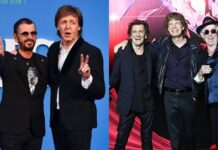By Ralph Greco, Jr.
There are a host of studio musicians, unknown arrangers, producers, writers, artists — gals and guys of every stripe, background and from every era — that have been (and will continue to be) the unknown or under appreciated talent behind the stars and big names. These are men and women who never get their due, their names (and faces) largely known to the general public, some who eschew the spotlight deliberately, others who are simply overshadowed, but still on whose shoulders this crazy thing we call rock and roll has been (and continues to be) built. There are plenty I didn’t name, so don’t get all up in arms about those hundreds of killer studio musicians and writers nobody has ever heard of. What follows is a subjective grouping that doesn’t even begin to scratch the surface…
1 & 2) Raphael Ravenscroft and Mel Collins — sax/reed players extraordinaire. Here’s a double-shot to start off because these guys play the same instrument. It is Ravenscroft’s iconic sax riff you hear on Gerry Rafferty’s “Baker Street.” He’s also played with Pink Floyd, Alvin Lee, Robert Plant and ABBA. Collins has lent his talent to Pink Floyd also, along with King Crimson, the Alan Parsons Project and Dire Straits. These two get around for sure, and though there are plenty of brilliant musicians to follow, I like mentioning horn players when I get the chance. Besides, that sax in “Baker Street” haunted my teenage years.
3) Michael Kamen. Bringing class into what some consider the classless bastion of rock and roll, Kamen has worked on soundtracks and solo albums, but most notably for this list with Metallica, Guns N’ Roses, Pink Floyd and a host of others. Kamen was the fuzzy-haired bearded dude you saw conducting an orchestra on those occasions when some too-cool-for-the-room rock band needed someone equally cool to score and conduct an orchestra for them. Dying way too soon for anybody’s liking, Kamen was big league rock and roll cool with classical chops.
4) Mick Ronson. There would be no David Bowie without Mick Ronson. OK, there I said it. It is Ronson who not only plays guitar on those early Bowie classics but it was the handsome blonde guitarist who arranged the strings for the Hunky Dory album, featuring “Life On Mars” and “Changes,” among others. Arrangers like John Paul Jones, Rick Wakemen and other notables on early rock and roll hits became extremely important when fledging rock and roll stars wanted strings or horns on a particular track but didn’t know how to get them. Bowie’s foil and guitarist of the original Spiders From Mars was well-versed enough to take the arrangement reins. Later, he partnered with Ian Hunter, forming the Hunter/Ronson band before the former’s solo album appeared under his name due to contractual reasons. There is hardly anyone Mick Ronson, who passed away in 1993, did not influence or work with. Check out Hunter’s “Michael Picasso” for a perfect tribute to Ronson.
5) Steven Van Zandt. The guy was on The Sopranos, hosts his own Underground Garage radio show, rounded up all those artists against apartheid for the Sun City protests, and plays guitar in a little outfit called the E. Street Band. But ‘Miami Steve’ as he was called back when he first teamed up with Bruce Springsteen in 1975, is lesser known, but just as influential for his production and songwriting. Shepherding, writing for and producing lesser-known Jersey guys Southside Johnny and the Asbury Jukes, Van Zandt is one of a handful of guys who should be credited with the Jersey Shore sound I believe even more than Springsteen himself. OK, I said it! Stepping into the Boss’s recordings during the infamous Born To Run sessions and arranging the horns for “Tenth Avenue Freeze Out” pretty much on the fly, Little Steven shares production credits on Springsteen’s Darkness On The Edge Of Town, The River and Born In The USA. His nasally vocal is often the go-to harmony for Springsteen live and next to Clarence Clemmons, it is Van Zandt Bruce audiences identify with at those rousing live shows.
6) Thom Gimbel. Another live show guy, but a guy nobody but nobody knows about (by his own doing), Gimbel is the backing musician’s backing musician. Having played most notably for Aerosmith and Foreigner, this is the guy who helps the Steven Tylers of this world hit their high notes in concert. Gimbel plays keys and guitar as well, but it’s his backing vocals I take specific note of when I see these bands live, realizing that without him “Dream On” would never sound that good.I hate to
7) Davey Johnstone. Never on anyone’s top guitarist list (though he should be), the lanky blonde has been Elton John’s arranger and guitar player since he joined the early 70s. One could argue that John has become a Vegas act, resting on his old hits and charging too much to hear them, but Johnson has never lost his chops or his importance on EJ’s music — live or on record. One of the few rock guitarists to be reckoned with for his ‘volume peddle’ prowess, his direction and influence on stage might be just as important as his guitar work.
8) Johnnie Johnson. As none other than Keith Richards himself noted in the 1987 film Chuck Berry Hail! Hail! Rock N’ Roll, Johnson just might be responsible for some of those early Chuck Berry hits we all know and love. Now, I’m not taking away Mr. Berry’s obvious skill with rock and roll poetry. I’m certainly not ducking out on his famous duck walk, his showmanship, or even his sloppy yet influential guitar playing. But as Richards pointed out, Chuck Berry wrote in some very unusual keys for a guitar player; more like the keys a piano player would choose. When interviewed for the movie, the ever-so-humble Johnson, who died in 2005, agreed that he was with Berry when those great hits were penned, but it’s a matter-of-fact admission. He apparently wasn’t aware nor would he have ever even considered what exactly he was contributing to the legend of rock n’ roll.
9, 10, 11, 12, 13) Art. OK, so I got carried away, but there’s a bunch of guys to pay tribute to in this category (and even more). Alton Kelly, Wes Wilson, Victor Moscoso and Rick Griffin (again just to name a few) were responsible for some of the most spectacular posters of the 60s psychedelic rock and roll era. Iconic posters that now fetch thousands of dollars were made for bands appearing at the Avalon Ballroom, Fillmore Auditorium and Carousel Ballroom in the golden area of ’66 and ’67 (and beyond). Sure, Bill Graham was the hard-headed champion, Santana manager and Fillmore owner who basically helped put the San Francisco sound on the map. All those wonderful bands paved the way sonically, but it can be argued (as I am doing here) that it was the weekly posters, the eye-catching mayhem of color, lettering and cartoons, the specific artist’s interrpretations of the bands listed for a specific gig (and back then, one evening’s show could feature bands of many different styles) that gave the whole movement its unforgettable look.
14) Gail Zappa. Finally, props need to go to a woman and oh what a woman she is. Adelaide Gail Sloatman, better know as Gail Zappa, is a force to be reckoned with, not only in relation to her husband’s recorded legacy but for musician’s rights in general. True, her acitivism began because of her campaign to release sanctioned CDs and DVDs of Frank Zappa’s work, running his labels, and fighting over digital downloads. Since then, she has made a cause of wading through record industry legal muck and mire, the quick closing of contractual loopholes and fighting for artists rights throughout the industry. She is a tireless lady and one worthy of inclusion on this almost all-male list.




















